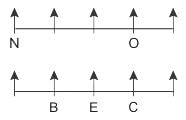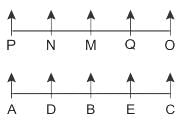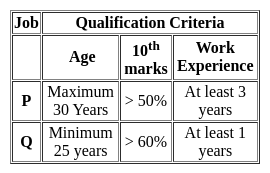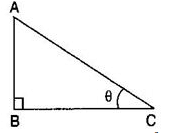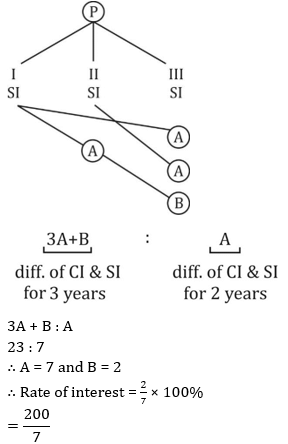Army Cadet College (ACC) Mock Test - 2 - Army Cadet College (ACC) MCQ
30 Questions MCQ Test - Army Cadet College (ACC) Mock Test - 2
Direction: Study the following information and answer the given questions carefully.
Ten people are sitting in two parallel rows such that people sitting in row 2 are just behind people in row 1. In row 1 - M, N, O, P and Q are sitting and all are facing north. In row 2 - A, B, C, D and E are sitting and all are facing north.
One who sits just behind O is to the immediate right of E. O sits 3rd to the right of N. B is neither at any of the extreme ends nor sits exactly behind O. P sits on a seat which is exactly ahead of A. D doesn’t sit at any of the extreme ends. M is not exactly ahead of E. Number of people sitting between C and E, is the same as the number of people sitting between E and B.
Q. Which of the following sits at one of the extreme ends?
One who sits just behind O is to the immediate right of E. O sits 3rd to the right of N. B is neither at any of the extreme ends nor sits exactly behind O. P sits on a seat which is exactly ahead of A. D doesn’t sit at any of the extreme ends. M is not exactly ahead of E. Number of people sitting between C and E, is the same as the number of people sitting between E and B.
To qualify for a job P, maximum age can be of 30 years, 10th marks should be more than 50% and work experience should be at least 3 years. To qualify for job Q, one should have a minimum age of 25 years, 10th marks should be more than 60% and work experience of at least 1 year. Rahul has 48% marks in 10th an age of 28 years and. work experience of 5 years. For which of these jobs does he qualify?
Direction: If a Paper (Transparent Sheet) is folded in a manner and a design or pattern is drawn. When unfolded this paper appears as given below in the answer figure. Choose the correct answer figure given below.
A piece of paper is folded and cut as shown below in the question figures. From the given answer figures, indicate how it will appear when opened.
Question Figure

Answer figure
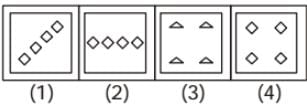
Question Figure

Answer figure

Directions to Solve
In each of the following questions find out the alternative which will replace the question mark.
Question -
Cloth : Mill :: Newspaper : ?
Direction: In each of the following questions, a related pair of words is followed by four pairs of words or phrases. Select the pair that best expresses a relationship similar to the one expressed in the question pair.
Peel : Peal
What is the discount percentage offered on a book having marked price Rs 2150 being sold at Rs 1892?
If altitude of the sun is 60°, the height of a tower which casts a shadow of length 30m is
The difference of compound interest and simple interest for 3 years and for 2 years are in ratio 23: 7 respectively. What is rate of interest per annum (in %)?
A water filling pipe P is 5 times faster than second pipe Q. If Q fills a cistern in 30 minutes. How long will it take to fill the tank, when both the pipes are kept in operation simultaneous ?
Krishna Raja Sagara reservoir, recently seen in the news, is located in which state?
Which Indian state passed a bill aimed at curbing illegal immigration?
Recently, Genetic rescue has been proposed to conserve the tiger population of which national park?
Recently, who won the National Women’s Carrom title for the twelfth time?
Who has been appointed as the Chief Executive Officer of BharatPe?
Which popular food delivery platform's subsidiary, Zomato Payments Private Limited, recently secured the Payment Aggregator (PA) License from the Reserve Bank of India (RBI)?
Direction: Out of four alternatives,choose the one which can be substituted for the given words/sentence.
A person coming to a foreign land to settle there
Direction: In the following question, the sentences have been given in Active/ Passive Voice. From the given alternatives, choose the one which best expresses the given sentence in Passive/ Active Voice.
Somebody told me that there had been an explosion in the Town Hall.
Direction: In the following question, the sentences have been given in Active/ Passive Voice. From the given alternatives, choose the one that best expresses the given sentence in Passive/ Active Voice.
A lion does not eat grass, however hungry he may be.
One way that you can recognize that a force is acting on an object:
Some dinosaurs had feathers although they could not fly but birds have feathers that help them to fly. In the context of evolution this means that
Presbyopia for human eye can be removed by using:
Which of the following illustrates the law of conservation of mass?
On which of the following issues did Liberals and Radicals defer ?
Where do minerals occur in sedimentary rocks?
Name the important Western industrial region in India
Consumer Protection Act (COPRA) was enacted by Indian Government in :
Why was the Treaty of Vienna drawn up in 1815?




